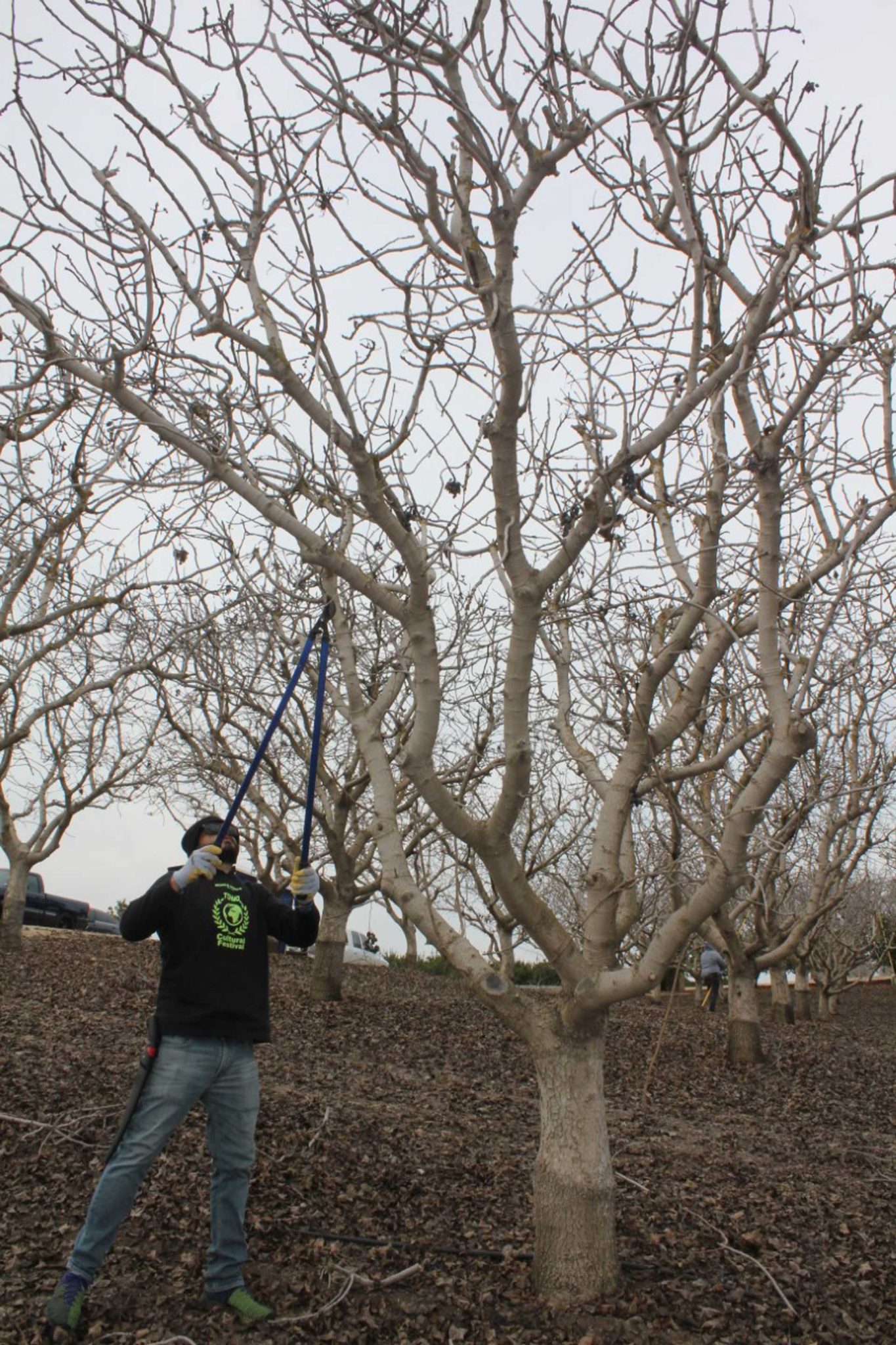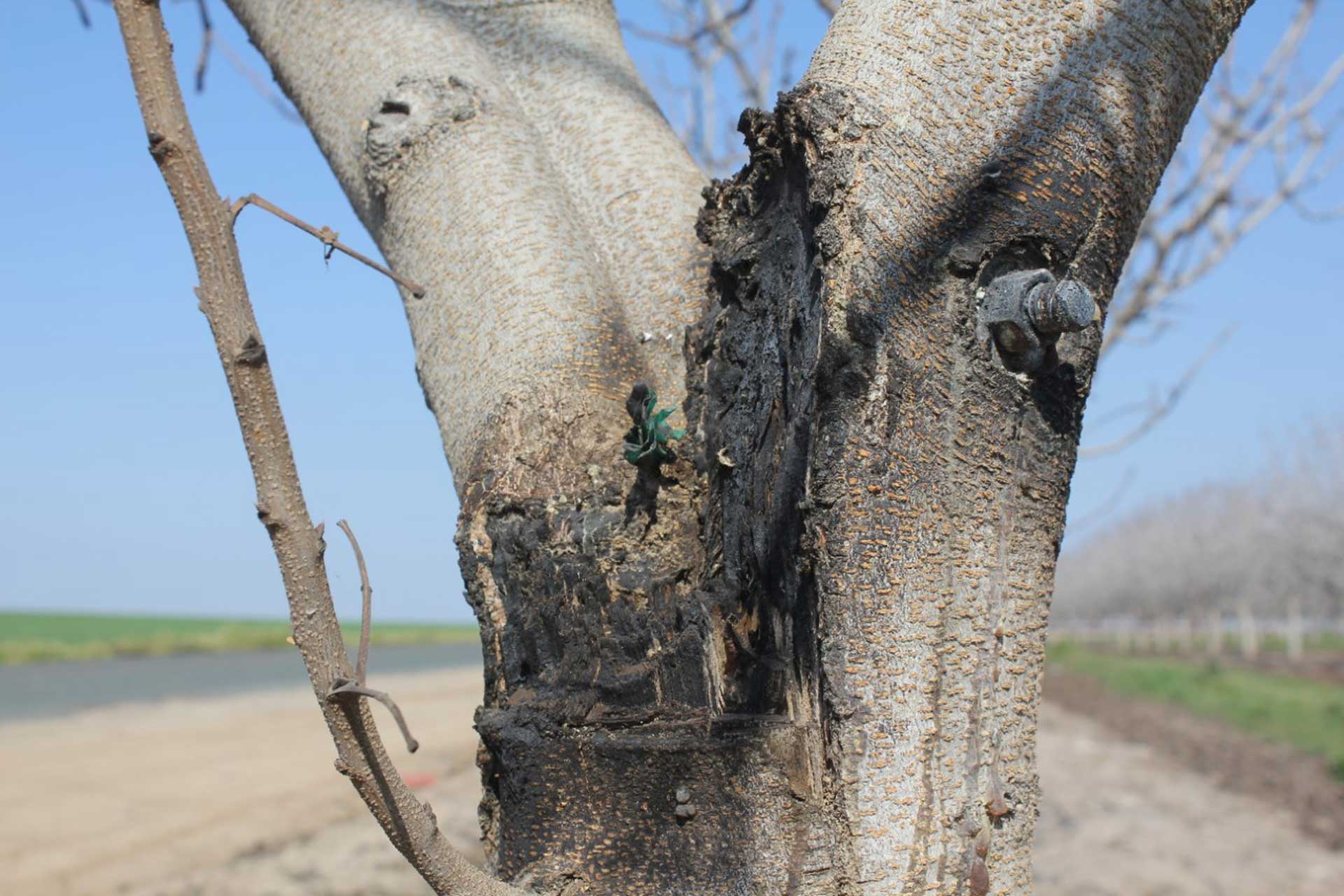
The Golden Hills pistachio variety has confirmed its strengths: more upright growth pattern, less pruning after maturity and early harvest. Since being released by the UC breeding program in 2005, growers have recognized these attributes and have planted more than 120,000 acres of Golden Hills pistachio trees in California.
UCCE Farm Advisor Craig Kallsen, in a presentation for the virtual Statewide Pistachio Day, noted the positives about this pistachio variety, but he also acknowledged crop production differences compared to the standard Kerman and some ‘fixes’ Golden Hills trees may need. Some of these weaknesses were apparent in early field trials, Kallsen said, and some were not.
His presentation included field fix suggestions and ways to address production differences.
Golden Hills Differences
Golden Hills has proven to be more difficult to bud than Kerman. Although the reason is not clear, Kallsen said that the length of Golden Hills branches that have flower buds and which will eventually be the bud stick tend to taper quickly. Bud maturity is often variable along the bud stick, with larger, older buds being too old and smaller buds too immature. Kallsen advised using a nursery licensed to distribute UC budwood and that is also familiar with budding Golden Hills trees. Buying pre-budded trees from the nursery is the most common practice.
Golden Hills trees should not be tipped late. They should be tipped before early February to be safe. The reasoning is that apical buds begin producing auxins in the spring which prevents buds lower on the branch from pushing. Apical buds should be tipped before they come out of dormancy.
With mature Golden Hills, everything happens earlier in the growing season compared to Kerman, Kallsen said. If terminal buds are tipped after the terminal buds come out of dormancy, buds a foot or more below that point will be extremely slow to push or won’t push at all. In contrast, with Kerman, the buds are dormant ten days to two weeks later, allowing more time for pruning in late winter.

Tree Training
Kallsen noted that Golden Hills trees have a greater tendency to split at the crotch of the tree during the initial years of bearing. Tree shaking at harvest appears to be associated with some of the splitting, Kallsen added. The split is at the primary scaffold branches and is more common when only two primary branches are formed, compared to at least three primaries. The splits can result in tree death if not addressed early. The initial split is often black or ‘sooty’ in color as mold grows on the sap leaking from the split.
A fix for these splits involves boring a hole at the top of the split perpendicular to the split and inserting at minimum a half-inch-diameter section of threaded rod through the trunk. Each end of the rod is then secured with a 1 3/8-inch-outside-diameter washer and nut.
When shaking, Kallsen added, the duration should be just long enough to remove the filled nuts only. Shaking should not be considered as an alternative to poling for removal of mummy nuts or blanks.
There is an alternative to the ‘vase style’ pruning being explored, Kallsen said. A modified single leader training may be a way to reduce splitting as there is not crotch. This experimental method of training is being pioneered by Jeb Headrick and investigated by UCCE researchers Bruce Lampinen and Mae Culumber.
Golden Hills also has a tendency to produce fewer primary and secondary scaffold branches at the training cut. Kallsen said cutting the young tree trunk or primary branches too early or too close to the terminal bud is more likely to result in insufficient or delayed bud push. He advised before making the training cut to look for or wait until developing buds are present in the axils of leaves below the proposed cut. The training cut should be made above a leaf axil that has a visible bud to maximize the chance that the buds in axils below the cut will push to form primary and secondary branches. Kallsen said this training method is particularly important in low-chill winters.
“Barking” at harvest is more likely with cultivars other than Kerman as the uneven trunk growth increases with age. Golden Hills and Lost Hills also increase in diameter faster than their rootstocks compared to Kerman.
Kallsen also warned about high levels of salts, especially boron in the irrigation water, which will have a negative effect on Golden Hills on UCB-1.
Internal kernel discoloration was discovered in some kernels of Golden Hills in 2020. Kallsen said the problem exists in Lost Hills, but is fairly rare in Kerman. The incidence of discoloration varies from year to year and orchard to orchard, Kallsen said, suggesting there is an environmental component. The cause and incidence requires further investigation, he added.
Scorch and Late Blight
Golden Hills appears to be more sensitive to scorch and subsequent defoliation at harvest time than Kerman or Lost Hills. Preventative measures include adequate irrigation throughout the season and particularly the last three to four weeks prior to harvest. Irrigating postharvest if leaves are green will maximize carbohydrate production. Kallsen said if late season sprays for navel orangeworm (NOW) control are necessary, chemical adjuvants known to cause phytotoxicity should be avoided.
In environments conducive to Alternaria late blight, Golden Hills, due to earlier maturity, may exhibit more late blight infections than Kerman. As the leaves begin drying earlier, there is the potential for providing Alternaria a place to grow late in the season in some years and locations. Kallsen said Golden Hills orchards might require a fungicide spray in late June or early July in the northern San Joaquin Valley and the more humid areas of the southern San Joaquin Valley.
Harvest
Kallsen advised not using hull tatter to gauge harvest readiness with Golden Hills as their hulls do not tatter as much as Kerman’s when ready for harvest. Once most hulls slip, harvest can begin. Most nuts will be split even if hulls are not tattered. Intact hulls may reduce NOW damage.
A plus for Golden Hills is a relatively shorter bloom period that translates into more even nut maturity than Kerman or Lost Hills.
Unless bloom was affected by weather or a poor-chill winter, Kallsen said a double shake is unnecessary for Golden Hills. In mature trees, when 10% of hulls begin to slip, waiting an additional eight to ten days to harvest can allow 95% of the nuts to come off the tree.
Even if a second shake is warranted, it can be completed before the first shake of Kerman.
More detailed results comparing the UC released cultivars from 2002 through 2018 can be found at calag.ucanr.edu/archive/?article=ca.2020a0011.

Cecilia Parsons
Cecilia Parsons has lived in the Central Valley community of Ducor since 1976, covering agriculture for numerous agricultural publications over the years. She has found and nurtured many wonderful and helpful contacts in the ag community, including the UCCE advisors, allowing for news coverage that focuses on the basics of food production.
She is always on the search for new ag topics that can help growers and processors in the San Joaquin Valley improve their bottom line.
In her free time, Cecilia rides her horse, Holly in ranch versatility shows and raises registered Shetland sheep which she exhibits at county and state fairs during the summer.















